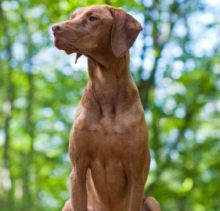Hungarian Vizsla
Lifestyle Needs

The Hungarian Vizsla is a medium to large Gundog. He has good stamina and is capable of working in all weathers – good at tracking, pointing and retrieving. He is a lively and intelligent dog whose natural skills and energy will need to be channelled into activities such as obedience training. He needs an owner who is energetic, firm and experienced at handling. Careful exercise up to 12 months is recommended as over exercicse can lead to joint problems in this long legged breed. Ideally, free running should not be allowed up to five months. The Vizsla breed club recommend 7.5 minutes exercise per month of age. Ideally he should live in a house with a garden, preferably adjacent to the open countryside. When mature he will need plenty of exercise every day. He has a short, coarse coat which is relatively easy to care for.
Genetic Diversity
(Known as Coefficient of Inbreeding: 'COI'. It should be as low as possible.)
The UK Kennel Club breed average COI is 5.3% - See 'A Beginners Guide to COI'
Gene Pool Size
(Known as Effective Population Size: 'EPS')
173.92
EPS is a measure of how many individuals are contributing genetically to a breed population. It is a measure of the size of the gene pool in a breed. Lower than 100 is considered critical by conservationists and below 50 brings a breed close to extinction. For more information see the Kennel Club article.
Health and Welfare Problems due to Conformation
(Body shape and physical characteristics)
- Gastric dilatation volvulus (GDV) (Bloat/torsion) Common in deep chested breeds.
BVA/KC Health Schemes: www.bva.co.uk/chs
- Hip dysplasia: breed 5 year mean score 11.4 (parents should be lower)
- Elbow dysplasia: score should be as low as possible
- Eye disease: Progressive retinal atrophy (PRA) (annual testing); Goniodysgenesis/Primary Glaucoma (G) (annual testing)
Estimated Breeding Values (EBVs) : EBVs for Hip Dysplasia are available for this breed
www.thekennelclub.org.uk/about-ebvs
DNA Tests Available
DogWellNet and IPFD Harmonisation of Genetic Testing for Dogs (HGTD)
www.dogwellnet.com/breeds
- Neonatal Cerebellar Cortical Degeneration
- Exercise Induced Collapse (EIC)
Availability of a DNA test does not mean that it is always necessary or even desirable for breeders to use this test.
Other Breed-Specific Health Screening Schemes
- Bitches should not produce a litter under two years old
- Bitches should not produce more than one litter within a 12 month period
Hungarian Vizsla Club Health page:
www.hungarianvizslaclub.org.uk/Health.html
Open Registry of Polymyositis Affected Vizslas:
www.vizslamyositis.blogspot.co.uk/p/blog-page_9200.html
Ask the breeder to show you the certificates for the above tests/screening for both parents. If any of the above tests have not been considered necessary by the breeder (and there may be good reasons), ask her to explain why.
Other Diseases Reported
(For which there are currently no genetic or screening tests for sire or dam)
- Allergies
- Autoimmune mediated diseases
- Polmyopathy: Breed club research: www.hungarianvizslaclub.org.uk/Health.html
- Cerebellar ataxia (rare)
- Cancers (various)
- Epilepsy
Ask the breeder about the medical history of the parents, grandparents and great grandparents. Consider carefully whether to purchase a puppy if some of these or other diseases are in the family line.
Ask about the breeder’s policy in cases of serious genetic diseases occurring to your puppy in later life. Good breeders will request to be informed of such events in order to improve future breeding decisions.
You are strongly advised to buy from a breeder who uses (or is prepared to use) the AWF Puppy Contract and Puppy Information Pack (PIP): www.puppycontract.org.uk
The breeder should also be familiar with the CFSG/DBRG Code of Practice for Dog Breeding